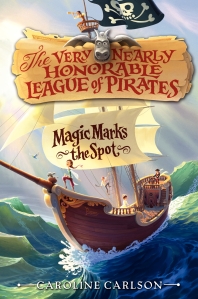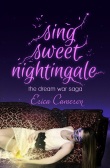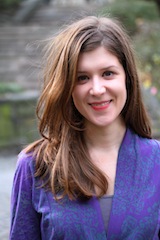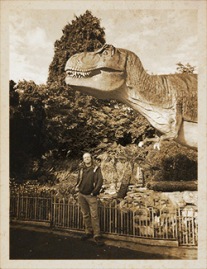Today we’re here with Caroline Carlson, author of THE VERY NEARLY HONORABLE LEAGUE OF PIRATES #1: MAGIC MARKS THE SPOT. I had the privilege of reading this book early, and it is SO fun, whimsical, humorous, adventurous, and action-packed! Or, as they say in pirate speak, Arrrrrr, ye be wanting this here book, and here be the reason why, matey, in the form of the official flap copy:
Pirates! Magic! Treasure! A gargoyle? Caroline Carlson’s hilarious tween novel The Very Nearly Honorable League of Pirates #1: Magic Marks the Spot is perfect for fans of Lemony Snicket’s Series of Unfortunate Events and Trenton Lee Stewart’s Mysterious Benedict Society.
Hilary Westfield has always dreamed of being a pirate. She can tread water for thirty-seven minutes. She can tie a knot faster than a fleet of sailors, and she already owns a rather pointy sword.
There’s only one problem: The Very Nearly Honorable League of Pirates refuses to let any girl join their ranks of scourges and scallywags.
But Hilary is not the kind of girl to take no for answer. To escape a life of petticoats and politeness at her stuffy finishing school, Hilary sets out in search of her own seaworthy adventure, where she gets swept up in a madcap quest involving a map without an X, a magical treasure that likely doesn’t exist, a talking gargoyle, a crew of misfit scallywags, and the most treacherous—and unexpected—villain on the High Seas.
Written with uproarious wit and an inviting storyteller tone, the first book in Caroline Carlson’s quirky seafaring series is a piratical tale like no other.
SHIVER ME TIMBERS! Ahoy! Ye landlubbers ought to read this beauty–or I shall make ye swab the poop deck! Arrrr!
Caroline, upon hearing so many pirate terms right in a row, pops into the room.
“AVAST, YE BUCCANEER,” I shout at her. “WALK THE PLANK!”
After a pause, I hang the jib and quietly remove my eyepatch, bandana, sword, and stuffed-animal parrot. “Forgive me mutiny,” I say, still donning my most terrific pirate accent. “But ever since I’ve read about Hilary’s adventures I can’t stop being a pirate.” I tip my hat in apology and then remember that I asked her here for a round of pirate-y (and not so pirate-y) questions…
LM: Where did the idea for THE VERY NEARLY HONORABLE LEAGUE OF PIRATES: MAGIC MARKS THE SPOT come from?
CC: I thought it might be interesting for you to see some of my very earliest notes about MAGIC MARKS THE SPOT, since I think they give a pretty interesting look at the evolution of an idea. Here’s the very first seed of the story, written about a year before I started drafting seriously:
a girl who tries to enroll in Piracy, but the admissions office refuses her application and instead forwards it to Young Ladies’ Finishing School. told partially in letters, postcards, ads, business cards, magazine clippings. imaginary world, very humorous.
I’m actually sort of surprised by how accurate this quick description turned out to be. Of course, the next thing I wrote wasn’t quite as true to the way the book ultimately turned out:
Cecily Kent escapes en route to (or directly from) the Finishing School, finds herself answering a want ad from a former/current pirate. Something about a wise woman who grows herbs in her garden. Maybe the pirate lives with his mom. Finishing School people come after her; they are also semi-powerful witches (Cecily’s mom was a garden witch but she has no powers herself). Everyone gets tangled up in some sort of journey/quest//treasure hunt during which Cecily gets to experience the high seas, etc. There is some sort of adorable sidekick…. Maybe a faux talking parrot – a talking rabbit? A talking…something else?
Over the course of my brainstorming notes, Cecily Kent becomes Hilary Westfield and the wise woman with herbs disappears, as do the witches. I abandon the idea of a talking rabbit (thank goodness) for a talking gargoyle, and my pirate gentleman no longer has to suffer the indignity of living with his mom. My notes get closer and closer to the final version of the story until, finally, I hit upon this idea:
The buried treasure is MAGIC.
If you’ve read MAGIC MARKS THE SPOT, you’ll know that this idea is at the crux of the plot; it’s crucial to the story’s conflicts, and it shapes the setting and characters. But how did I think of it? With many pages of rambling about talking rabbits, I guess.
Also, I think I should state for the record that in my earliest notes about Hilary’s mentor, the pirate Jasper Fletcher, I refer to him as “the Cary Elwes pirate guy.”
HA! Cary Elwes pirate guy is the absolute BEST character note I’ve ever heard! You officially win at life, Caroline. Anyway, it’s amazing how much your story ideas evolved and changed! When you finally were ready to sit down and write MAGIC MARKS THE SPOT, was the plot fully formed, or did you change things as you went along? Essentially… are you a plotter or a pantser? And what is your writing process like?
I’m mostly a plotter. Before I start writing a book, I like to know very specifically what will happen in the first 20 pages, and I like to have a general idea of what will happen after that. I also need to know what the climax of the book will be, and I usually have ideas for one or two scenes I’d like to include along the way.
I actually did very extensive prewriting for MAGIC MARKS THE SPOT; this was unusual for me, but I was a student at Vermont College of Fine Arts at the time, and my advisor, Martine Leavitt, asked me lots of questions before I began drafting: What does your main character want, and why can’t she have it? What is the moment of the story when her quest becomes hopeless? What is her moment of epiphany? How will the story’s ending mirror its beginning? I won’t lie: These questions intimidated me, and I couldn’t answer several of them right away, but just thinking about them helped me understand the broader shape of the story right from the very first draft. Now I challenge myself to think about all of these questions whenever I start a new story.
As much as I love to plot, I’ve also found that if I plot too much, I end up stifling my story because I don’t leave room for all those little moments of inspiration that can happen during the day-to-day writing process. For me, what seems to work best is knowing the broad strokes of the story in advance but leaving the details up in the air until the last minute.
As far as my writing process goes, I almost always write in chronological order, I try to write 1000 words a day (though I don’t always succeed), and I am physically incapable of writing a truly messy draft. This means I revise as I go, so I’m a fairly slow writer, but my first complete draft of a book is usually decently close to the final version. (And by “decently close,” I mean that I will only have to re-write a third of the book from scratch. For MAGIC MARKS THE SPOT, I ended up re-writing the final third of the book from scratch. For its sequel, I re-wrote the first third of the book.)
Rewriting a third?!? WOW, that’s intense! I admire your dedication! And I love your description of plotting in advance but also leaving room for surprise inspiration. Was there a particular scene from the book or character that tumbled onto the page differently than you had imagined? What surprised you most about your own story?
The character who took me the most by surprise was Claire, Hilary’s roommate at finishing school. I hadn’t planned for Hilary to have a roommate; Claire just popped into existence out of nowhere as I was writing the scene in which Hilary arrives at school, and I decided to let her hang around for a while. Claire has turned out to be one of my favorite characters, and she’s very useful: She writes letters to Hilary throughout MAGIC MARKS THE SPOT, providing crucial information about the situation on the mainland, and she provides a little comic relief when life gets tough for Hilary. Unlike Hilary, she’s not from a privileged background, and she loves traditionally girly enterprises like dancing and dressing up, so she’s often able to offer a point of view that contrasts nicely with Hilary’s. On top of all that, she’s very important to the plot of the second and third books. I can’t imagine the series without her, so it’s hard for me to believe that she started out as an unplanned whim.
Well, I LOVE Claire, so I’m glad she popped into existence, and I’m very excited to hear she’ll have a major role to play in the second and third books! Speaking of second and third books, what has publishing a series been like, and how do you think your debut experience differs from the debut experience of an author who is coming out with a stand-alone?
I didn’t originally conceive of MAGIC MARKS THE SPOT as the start of a trilogy, but from pretty early on, I could tell that it was the sort of book that might be able to support sequels: I still loved the world and the characters I’d created, and there was still plenty of good storytelling material that I hadn’t gotten to use in the first book. So when HarperCollins very generously offered me the chance to write two more books about Hilary and the pirate league, I said yes right away.
Having three books under contract is obviously a wonderful thing–barring catastrophe, I’ll have three books published, and I can make plans for the trilogy as a whole without waiting to find out if my publisher will be willing to pick up book 2 or book 3. I feel very fortunate to be in this position. But writing a series comes with a whole new set of creative and psychological challenges, too. You want readers who loved your first book to feel that the second and third books are worthy companions; you want to continue the story, ramp up the tension, and ensure that your characters grow and change. Oh, and you need to figure out what happens in those second and third books.
From talking to my fellow Lucky 13s, I know that writing a second book can be difficult for any author. You have to deal with worries that your second book won’t live up to your first, or that you are a one-hit wonder who will never be able to write a decent sentence again. If that second book is under contract, you might worry that you’ll let down your editor or your publisher; if you’re not under contract, you might worry that your new book will simply never sell. And when the second book is part of a series, you are learning how to write a series at the same time that you’re wrestling with all of the normal second-book jitters. I think what I’ve discovered over the past year is that writing a second book is immensely challenging, no matter what, and I’m thoroughly impressed with every author who achieves it!
Well, I’m sure you’ll prove equal to the challenge! I’m very glad HarperCollins offered on two sequels; I can’t wait to have more Hilary, gargoyle, and the rest of the Pigeon’s crew in my life! Speaking of your publisher, what was the most surprising thing about the publication process? And what was the most exciting part for you?
Hmm, good questions! The most surprising thing for me has been realizing how many people work incredibly hard to create a book. Of course I knew that agents and editors and designers and publicists and marketing teams and artists were all part of a publishing team, but I have been constantly humbled by how much thought, care and effort each person has put into making this book the best book it can be. MAGIC MARKS THE SPOT started off belonging only to me, but now it belongs to lots of wonderfully talented people, and it’s so exciting to see all of that collaboration come together in the finished book.
As for the most exciting part of the publication process, I’ve had lots of lovely moments so far, but the most exciting was the very first time a child read my book.
Awwww real live middle grade reader?!? That’s so cute! And it’s so lovely to hear about the team supporting MAGIC MARKS THE SPOT. Forgive the non-sequitor, but I was hoping we could do a speed round of questions….
E-readers or physical books? Physical books!
Fantasy or realistic fiction? Either, as long as it’s clever and engaging (and maybe even funny).
Very Nearly Honorable League of Pirates or a Freelance Pirate Crew? Freelance pirates!
Parrot or gargoyle? GARGOYLE.
Eye-patch or peg-leg? Eyepatch.
Morning writing session or night writing session? Morning, definitely.
Writing with music or writing with silence? Silence–I’ve tried writing to music, but it just doesn’t work for me.
Rainy writing day or sunny writing day? I’m much more productive on sunny days.
Long-hand or computer? Computer.
Coffee or tea? Tea–particularly Yorkshire Gold tea.
And most important of all: cheese or chocolate? Chocolate is nice, but cheese–well, cheese is the food of the gods.
You are SO right about cheese. It’s DIVINE. One last question for you: as this community is All for One and OneFour KidLit, we’d love to know two or three books that inspired you as a kid!
HALF MAGIC and its companion books by Edward Eager are some of my all-time favorites; I love how they combine fantasy, humor, and wonderfully likable characters. I also adore the ANASTASIA KRUPNIK books by Lois Lowry, which are completely hilarious and also feature great characters who’ve stuck with me for years.
Arrrrr, thanks for joining us, Caroline!
 Thanks for having me on the OneFour KidLit blog, Lauren! It’s been so much fun!
Thanks for having me on the OneFour KidLit blog, Lauren! It’s been so much fun!
Meet the Author:
Caroline Carlson is the author of MAGIC MARKS THE SPOT, a funny and fantastical seafaring adventure for young readers. She grew up in Massachusetts and holds a BA from Swarthmore College and an MFA from Vermont College of Fine Arts. Caroline lives with her husband in Pittsburgh, Pennsylvania, amidst many stacks of books.
 Lauren Magaziner is a 4th grader at heart, watches way too much TV, and loves to steal people’s toes to make Toecorn, which tastes like chewy, meaty popcorn. Only one of those is true. (Okay… you caught me. They’re all true.) Her MG debut THE ONLY THING WORSE THAN WITCHES—about a boy who becomes a witchling’s apprentice in a town full of dangerous, Toecorn-loving witches—is forthcoming from Dial/Penguin in Summer 2014. Lauren Magaziner is a 4th grader at heart, watches way too much TV, and loves to steal people’s toes to make Toecorn, which tastes like chewy, meaty popcorn. Only one of those is true. (Okay… you caught me. They’re all true.) Her MG debut THE ONLY THING WORSE THAN WITCHES—about a boy who becomes a witchling’s apprentice in a town full of dangerous, Toecorn-loving witches—is forthcoming from Dial/Penguin in Summer 2014. |
 Heidi Schulz is a writer, reader, and giraffe suspicioner. Her debut novel for middle grade readers, HOOK’S REVENGE, will be published by Disney•Hyperion in Fall 2014, followed by her picture book debut, GIRAFFES RUIN EVERYTHING, by Bloomsbury Kids, in Fall 2015. She lives in Salem, Oregon with her husband, their teen daughter, a terrible little dog, and five irascible chickens. Connect with her on Twitter or Facebook.
Heidi Schulz is a writer, reader, and giraffe suspicioner. Her debut novel for middle grade readers, HOOK’S REVENGE, will be published by Disney•Hyperion in Fall 2014, followed by her picture book debut, GIRAFFES RUIN EVERYTHING, by Bloomsbury Kids, in Fall 2015. She lives in Salem, Oregon with her husband, their teen daughter, a terrible little dog, and five irascible chickens. Connect with her on Twitter or Facebook.


 Emily Lloyd-Jones lives on the western edge of California, where she works in a bookstore by day and writes YA novels by night. She’s addicted to coffee & the internet. When not writing, she’s usually online or playing with her neurotic cat. She wastes a lot of time on
Emily Lloyd-Jones lives on the western edge of California, where she works in a bookstore by day and writes YA novels by night. She’s addicted to coffee & the internet. When not writing, she’s usually online or playing with her neurotic cat. She wastes a lot of time on 














 Today on the blog we’re interviewing Lucky13 author
Today on the blog we’re interviewing Lucky13 author 










